Douglas Daniels Directors Portfolio
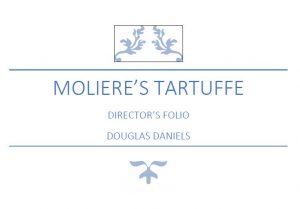 Director’s Vision
Director’s Vision
It was Brecht who said that “Art is not a mirror to reflect reality, but a hammer with which to shape it” and in my production of Moliere’s “Tartuffe”, Brecht will not be let down. I will be challenging the audience’s perception of the world around them through examining power dynamics in relationships as expressed through powerful and emotive performances of the actors inspired but forms such as Lecoq and Commedia. This will be combined with abstract sets and costumes with vibrant colours giving insight on different characters to the audience.
Whilst I have been inspired by Moliere’s writing of “Tartuffe” it is important to note that our society is dramatically different from that of Moliere’s 1660s France. Society today is highly secularised (unlike Moliere’s) and therefore I have chosen to down play the religious undertones and reinterpret the persona of Tartuffe in a political light to ensure that the play remains relevant to a modern audience. Ultimately, Tartuffe metaphorically represents much more than purely a religious impostor, rather the character of Tartuffe acts as a representation of how people of influence – whether it be friends or political leaders- have the ability to manipulate those seeking direction. This is particularly seen through the character of Orgon who is a sycophant of Tartuffe and who adored him so much that he was taught to “kill my (Orgon’s) feelings of love” and changed himself for the imposter. Therefore, through emphasising this dynamic to the audience, they will be made accountable to examine their relationships with friends and perhaps most importantly leaders, to ensure that they do not lose their sense of identity like Orgon.
In my production, the character of Tartuffe will be based off the health and wellness influences who are prevalent on social media today. They fuel unreasonable expectations about health, whilst living lives that contradicts what they preach, like Tartuffe. Importantly, Tartuffe is also portrayed as being spiritual, rather than religious in this production.
I intend to have the entire cast on the stage for the entirety of the play. This is to ensure that they are able to interact with what is happening on stage and can react (via Gestus) as well. Therefore, I have chosen to set the play at the Sydney Theatre Company’s Wharf Theatre, as the space is large enough to allow the cast to be on stage the entire time, yet it is not too big ensuring that the actors are not engulfed by a cavernous stage. The physicality of Lecoq has inspired me greatly and has impacted the way that I have worked with my actors, ensuring that they do not rely on the spoken word but rather use their bodies to tell a story. The use of Lecoq has required me to change my costumes to allow for the actors to be unrestricted, hence whilst it is inspired by regency fashion it remains contemporary, allowing for maximum movment.
Overall, through appealing to sense of the audience, after having watched the play I want to ensure that they have the tools to examine their own lives and change it to get rid of “their Tartuffe”.
Vision Board
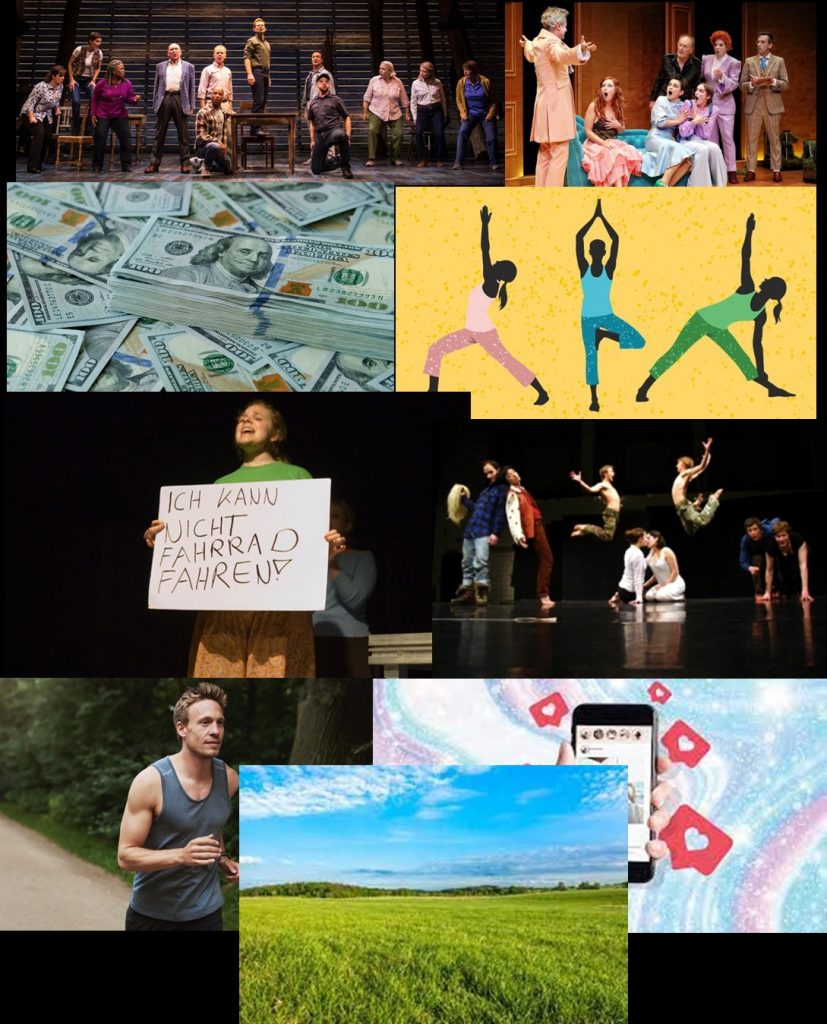
Background
The Playwright.
Moliere, (born Jean-Baptiste Poquelin) is arguably one of the most eminent of the 17th century and of French literature in general. As he was born in France in 1622 into a wealthy family. He was well educated having studied law before deciding to go into theatre. His context is extremely important to truly understand the play, and his time was dominated by religion, particularly Roman Catholicism as it was the state religion. Since the Reformation in 1516 there had been a series of conflicts known as the French Wars of Religion, in which the Catholics attempted to eradicate the Huguenots (this was what the French protestants were referred to as). Moliere would have witnessed this throughout his life as it was his patron, Louis XIV who increased the restrictive laws that ensured the Huguenots were disenfranchised. Whilst he was a Catholic (at least technically), this did not stop Moliere from using his artform to criticise the Catholic Church and how it functioned as Political institution. Arguably, the Church that Moliere is critiquing in “Tartuffe” is far more of a political and financial institution than it is a spiritual one. This is exemplified by Cardinal Mazarin and Cardinal Richelieu, both whom served as prime ministers of France during Moliere’s lifetime and lived more like princes than prelates.
Moliere used a variety of techniques to highlight societal issues in all of his plays, particularly satire to highlight the hypocrisy of the bourgeoisie and the elite. This is not exclusive to “Tartuffe” but is also seen in his other plays such as “The Miser”. Like most theatre in 17th Century France, Moliere was strongly influenced by Italian theatre, particularly Commedia dell’arte. Moliere also had elements of the ancient Greek tragedies in his plays. Also he did not always stick to the strict class structure that were generally expected at the time, with the comedic characters from the lower classes or as seen in “Tartuffe” for the servants to be without wisdom, as it is Dorine who is extremely wise despite being a servant. Overall, Moliere was not bound by the theatrical paradigm of the time and he was more than willing to challenge it as exemplified by his character in Tartuffe.
Set design
Whilst in my production of “Tartuffe” I have been inspired by theatrical practitioners such as Brecht and Lecoq, it is not a purist representation, rather than the minimalist set, I have presented mine as more abstract and eclectic. I chose the Sydney Theatre Company’s Wharf Theatre due to the fact that whilst the stage is not small it is nevertheless intimate, a feature that was important to me. Elements of Brecht have influenced me in design of the set and props, particularly the idea of how I can use the v-effect/alienation and how I can make this obvious to the audience. I chose to do this through lighting, costumes and props such as placards. As the production of the play is set in the present day the set looks similar to a lounge room in a house to highlight the middle-class nature of the family and how very similar, they are to the audience. This sense of familiarity with set also allows for the audience to see how “Tartuffe” and themes such as hypocrisy and manipulation relate to them personally.
Below: Wharf theatre 2

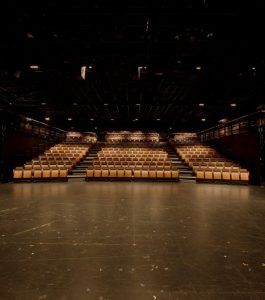
Set
When creating the set, I choose to use elements of design that would remind the audience of their own homes. Therefore, I choose to use a small number of pieces of furniture – an armchair, lounge and dining table – to present to the audience some veneer of comfort, allowing them to expect something conventional only to be left surprised. I purposely avoided the option of making the set too entrenched in realism as I want the focus of the audience’s attention to be on the physicality of the actors as well as what they are saying. The furniture itself is Scandinavian/ minimalist, whilst this appears trivial it feeds into the whole idea of Tartuffe being a new age spiritual guru who has corrupted Orgon and perhaps most importantly the idea of how the middle class feel through acquiring more material possessions that they shall find more meaning in their lives.
A tone constant of the set is white. White is featured in the set, furniture and props. White of course, symbolises purity and innocence everything that Tartuffe claims to be but in reality, is not. Additionally, the white also symbolises perfection, the perfection that Orgon is attempting to gain through his interaction with Tartuffe despite it being against his better judgement.
A central feature of the set is the backdrop of green, lush garden. This to contrast with the whites and man-made furniture, as Orgon derives his meaning in life from his possessions or from looking to Tartuffe rather than exploring the world right outside his loungeroom. This also links to a key conceptual focus of how society attempts to find value through material possessions and trends rather than construct their meaning from self-discovery.




Above: Belvoir’s “Cherry Orchard” served as inspiration in terms of set
Below: the Sydney Theatre Company’s production of “The Resistible Rise of Arturo Ui” influenced me in its use of props and Brechtian techniques.
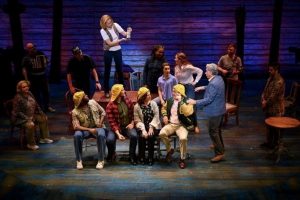
 Lighting
Lighting
Lighting plays a significant role in creating tone for both the play and the audience. I chose to use bright,
white lights. This primarily drawn from Brecht and his use of the v-effect. By using bright white lights, the audience is not lulled into a stuper but rather forced to pay attention to what is happening on stage. The use of bright lights also symbolises Orgon’s belief that Tartuffe is angelic and will be light who leads him out of the darkness. The lights will also ensure that the whole stage is bathed in light, serving a practical purpose as it allows the actors to be seen very clearly.
right: an example of lighting
Costumes
Overall, I chose to use contemporary clothing in my costumes but to have different characters dress in entirely different ways depending on their characters. In doing this I did rely on stereotypes of people, for example what to fitness fanatics wear or what would teenagers wear for certain characters. Overall, I desired the costumes to be minimal, ensuring that character was formed through their physicality and acting rather than their costumes.
As I have reinterpreted the persona Tartuffe to be a “new age spiritual health guide” to Orgon it was important that he at least appear to fulfill that description even is manners and actions do not. Therefore, to give him this veneer I decided to dress him as though he was a personal trainer/ yoga instructor. Tartuffe wears a white as he is of course meant to be pure, and in this production, he has found “inner peace”. Yet, his white cloths are stained and frayed to symbolise his lack of morality but also how he does not follow the rules that he presents Orgon with.
Below: (going from left to right) examples of Elmire’s, Orgon’s and Tartuffe’s costumes.
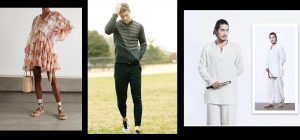
Other characters such as Orgon and Madame Pernelle attempt to copy the way that Tartuffe dresses as they attempt to replicate him in every aspect of their lives. These two characters wear black, symbolising their submission to Tartuffe. Elmire (Orgon’s wife) dress more individually, with her wearing a flowy, floral print dress that allows her to move but also makes it obvious that she is a woman of means.
The Characters of Marianne and Valere who as young, star-crossed lovers pine for each other despite the attempts of Tartuffe to pursue Marianne. The two lovers wear costumes that contain bright colours mainly pinks and red as they symbolise passion and desire. The use of pink and reds acts as an important visual tool as it symbolises how they have not followed Tartuffe’s desires or become entrapped in his lies like Orgon has. It also acts as an expression of the freedom and lack of responsibility they have due to their youth, meaning they have no. deep desire for spiritual fulfilment outside of the now. Never the less they will still dress like “normal” teenagers.
 above: an example of the costume that Marianne would wear.
above: an example of the costume that Marianne would wear.
Working with the actors
I want my production (and therefore the actors) to pay homage to three theatre practitioners: Brecht, Lecoq and of course Moliere. I decided in terms of the acting, the tools provided by the theatre practitioners of Brecht and Lecoq would be invaluable in modernising “Tartuffe” whilst staying true to the conceptual focuses such as hypocrisy in society as highlighted by Moliere. Both practitioners revolutionised physicality and theatre, this what I wanted to inspire the actors with.
One of the primary focuses that I worked on with the actors was physicality. Physicality is crucial to every play; however, I wanted the actors to not just rely on the spoken words but to also use their bodies to tell a story and show emotion. The use of physicality as inspired by Lecoq also acts as a vital way to express tension between the characters as well as emphasis elements of comedy as seen in the interaction of Tartuffe and Elmire.
A scene I worked on with the actors to implement elements of Lecoq was Scene 5, Act IV, in which Tartuffe is attempting to woo Elmire whilst Orgon is hiding under a table. With the actors I emphasised the importance of dramatic tension and status. To create tension, we did an exercise that revolved around the actors playing Tartuffe and Elmire doing a push and pull activity using a large elastic band around their waists which was inspired by Lecoq. Before we spoke lines, I wanted the actors to experiment with the tension. What would happen if Elmire attempted to move away? Ultimately, Tartuffe would be pulled towards her. This idea of push and pull was important as it showed the repugnance of Tartuffe. For example, once we stopped using the rubber band and started using lines there was an obvious amount tension as seen the physicality of the two actors. So when Tartuffe said “My soul needs something to get a hold of” as he lunged for Elmire’s breast, you could see the tension purely through the way that as Tartuffe moved forward, Elmire quickly moved back creating tension as we had practised.
I then worked on highlighting the hypocrisy of Tartuffe. For example, he promotes health and spiritual wellness to Orgon, yet in private I portray him as indulging in alcohol and fast foods despite his warning Orgon not to consume it. In this scene with Elmire where he is attempting to be sexual with her, I got the actor to be smoking a cigarette in one hand as he was attempting to grope Elmire. And obviously smoking is very bad for your health and therefore displays to the audience how much of a hypocrite Tartuffe truly is.
We worked on the emotional manipulation of Orgon by Tartuffe, particularly in act 3, scene 6 where Orgon said “How dare you besmirch this pure man’s name?” this (as the audience knows) is extremely ironic as he is only one who still believes it other than his mother. In working with the actor playing Orgon it was important that he play this line with truth. This is to heighten the emphasis on the conceptual focus of manipulation (and the dramatic irony), as everyone, including the audience, knows that Tartuffe is a conman other than Orgon, but as people keep on telling this he just retreats more and more into his relationship with Tartuffe.
Overall, it is important for the actors to work on these areas of physicality and emotion/ truth to present a powerful performance.
